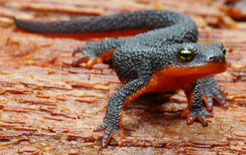Newts & Salamanders
What are newts?

Newts belong in the family of Amphibia along with frogs and toads, and are ancestors of the first aquatic vertebrates that colonized land. Newt is a common name applied to certain members of a family of relatively small salamanders (see below).
They can be found only in America and in the temperate zones of Northern Africa, Asia and Europe. They live under stones in streams and under logs or leaves in moist forests.
What are salamanders?

There is little distinction between the newt and salamander. Salamanders have soft, moist skin covering their long bodies and even longer tails. They have no scales, claws or external ear openings. The larva are sometimes confused with the frog tadpoles, but their heads do not get as large as the tadpoles. They have feather gill structures present just behind the head on the sides of the neck area, and their front legs develop first.
The majority of the salamanders and their larva are carnivorous, taking in insects, small invertebrates. The large adults eat fish, frogs and other salamanders.
There are three types of salamanders: totally aquatic, semi-aquatic, and completely terrestrial. The aquatic live out their complete life cycles in the water. The semi-aquatic live primarily on land, hibernating during the winter, and enter the water as breeding season begins. After mating and egging is complete, they once again return to land. The terrestrial salamanders spend their entire lives on land, rarely entering the water though they are never far from it.